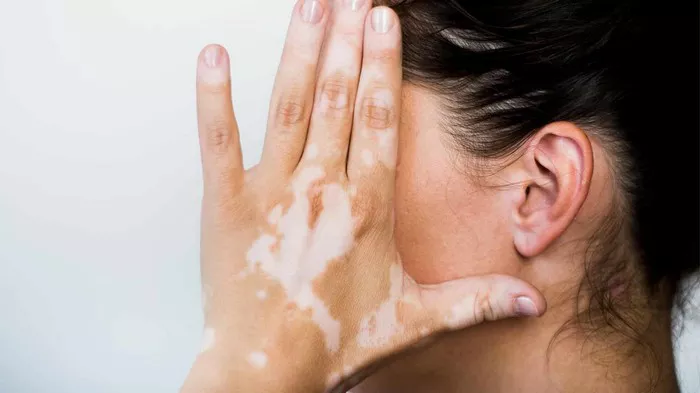Vitiligo is a skin condition that leads to the loss of skin color in patches. It can appear on various parts of the body, including the hands. Understanding how vitiligo starts on hands is crucial for those affected. This article will explore the causes, symptoms, diagnosis, and treatment options for vitiligo, especially as it pertains to the hands.
What is Vitiligo?
Vitiligo occurs when melanocytes, the cells responsible for producing melanin, are destroyed or stop functioning. Melanin is the pigment that gives skin its color. When these cells are lost, white patches appear on the skin. Vitiligo can affect people of any skin type or color, but it may be more noticeable on darker skin.
How Does Vitiligo Start?
1. Genetic Factors
Vitiligo can have a genetic component. If someone in your family has vitiligo or other autoimmune diseases, you may be at higher risk. Research shows that certain genes may make individuals more susceptible to the condition.
2. Autoimmune Response
In many cases, vitiligo is considered an autoimmune disorder. This means that the body’s immune system mistakenly attacks its own cells. The immune system may target melanocytes in the skin, leading to their destruction.
3. Environmental Triggers
Several environmental factors may trigger vitiligo. These can include:
Sunburn: Severe sunburn can damage skin cells and may trigger vitiligo.
Chemical Exposure: Certain chemicals, like those found in hair dyes or skin products, can damage melanocytes.
Skin Trauma: Cuts, scrapes, or burns can sometimes initiate the process of vitiligo.
4. Stress Factors
Emotional and physical stress can play a role in the onset of vitiligo. Stress can influence the immune system, potentially triggering autoimmune responses.
Initial Signs of Vitiligo on Hands
1. Patchy White Spots
The most noticeable initial sign of vitiligo is the appearance of small, patchy white spots. These spots usually start small but can gradually grow larger.
2. Loss of Skin Color
The areas affected by vitiligo lose their natural color. On hands, this can create stark contrasts between the affected areas and the surrounding skin.
3. Changes in Skin Texture
In some cases, the skin texture in the affected areas may change slightly. However, it generally remains smooth.
4. Symmetry of Patches
Vitiligo often develops symmetrically. This means that if one hand has spots, the other hand may develop similar patches.
Why Do Hands Get Affected?
Hands are frequently exposed to sunlight and various environmental factors, which can increase the likelihood of developing vitiligo in this area. Additionally, the skin on the hands is thinner and may be more vulnerable to damage.
Diagnosis of Vitiligo
1. Physical Examination
A healthcare provider usually diagnoses vitiligo through a physical examination. They will look for the characteristic white patches on the skin.
2. Medical History
Doctors will ask about your medical history, including family history of vitiligo or other autoimmune diseases. This information can help identify potential risk factors.
3. Wood’s Lamp Examination
In some cases, a Wood’s lamp may be used to examine the skin under ultraviolet light. This can help highlight areas of depigmentation that may not be easily visible under regular light.
4. Skin Biopsy
In rare cases, a skin biopsy may be performed to confirm the diagnosis. This involves taking a small sample of skin and examining it under a microscope.
Treatment Options for Vitiligo on Hands
1. Topical Treatments
Topical corticosteroids are often prescribed to help restore skin color. These medications can help reduce inflammation and may stimulate melanocyte activity.
2. Light Therapy
Phototherapy involves exposing the skin to ultraviolet (UV) light. This treatment can help stimulate the production of melanin.
3. Depigmentation Therapy
For those with widespread vitiligo, depigmentation therapy may be an option. This involves using topical agents to lighten the remaining pigmented areas of skin, creating a more uniform appearance.
4. Skin Grafting
In some cases, skin grafting may be considered. This involves taking a small section of skin from an area with normal pigmentation and transplanting it to an affected area.
5. Cosmetic Solutions
Makeup and self-tanners can help mask the white patches on the hands. These solutions can provide temporary relief and boost self-esteem.
6. Support and Counseling
Living with vitiligo can be challenging. Support groups and counseling can help individuals cope with the emotional and psychological aspects of the condition.
Living with Vitiligo on Hands
1. Skin Care
Proper skin care is essential for managing vitiligo. Use mild soaps and moisturizers to keep the skin hydrated. Sun protection is crucial since the affected areas are more sensitive to UV light.
2. Sun Protection
Wearing sunscreen with a high SPF is vital for protecting the skin from sunburn. White patches can sunburn more easily than pigmented skin.
3. Healthy Lifestyle
A healthy lifestyle can support overall skin health. Eating a balanced diet rich in vitamins and minerals can help maintain skin health.
4. Emotional Well-being
Coping with the emotional impact of vitiligo is essential. Many people find it helpful to connect with others who have similar experiences.
Conclusion
Vitiligo can start on the hands and may be influenced by various genetic, environmental, and autoimmune factors. Recognizing the early signs, such as patchy white spots and changes in skin texture, is crucial for timely diagnosis and treatment. Although there is no cure for vitiligo, various treatment options are available to help manage the condition. Living with vitiligo can be challenging, but with the right support and care, individuals can lead fulfilling lives.
If you suspect you have vitiligo or are experiencing skin changes, consult a healthcare professional for personalized advice and treatment options. Understanding your condition is the first step toward managing it effectively.
Related topics:



























